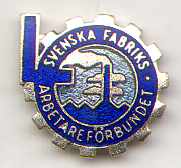
The Scottish Trades Union Congress (STUC) is the national trade union centre in Scotland. With 40 affiliated unions as of 2020, the STUC represents over 540,000 trade unionists.

IG Metall is the dominant metalworkers' union in Germany, making it the country's largest union as well as Europe's largest industrial union. Analysts of German labor relations consider it a major trend-setter in national bargaining.

The Swedish Building Workers' Union is a trade union representing workers in the construction industry in Sweden.
The Federated Rubber and Allied Workers' Union of Australia was an Australian trade union which existed between 1909 and 1988. The union represented workers employed in manufacturing rubber, plastic, electrical cable, adhesive and abrasive products in Australia.

The Federated Ironworkers' Association of Australia (FIA) was an Australian trade union which existed between 1911 and 1991. It represented labourers and semi-skilled workers employed in the steel industry and ironworking, and later also the chemical industry.
Die Spoorbond was an Afrikaner railway trade-union formed in 1934 by H. J. Klopper, founder of the Afrikaner Broederbond, which advocated a policy of replacing all black railway-workers with Afrikaners. It rejected strikes and called instead for loyal service to the South African Railways and Harbours Administration (SARHA). The union had a membership of some 16,000 in the 1930s, considerably more than that of its rival, the National Union of Railway and Harbour Servants, which was forced to dissolve in 1937.
The General Union of Loom Overlookers (GULO) was a trade union representing junior supervisors in textile manufacturing in the United Kingdom. While most members were based in Lancashire, it also had members in Yorkshire, East Anglia and Essex.
The Building and Construction Union was a trade union representing building workers in West Germany.
The Textile and Clothing Union was a West German trade union representing textile and clothing workers.
The Leather Union was a West German trade union representing workers in shoemaking, tanning, saddlery, and other work related to leather.

The General Union is a general union representing workers in Belgium.
The Union of Land, Food and Forests was a trade union representing workers in various related industries in East Germany.
The Industrial Union of Chemicals, Glass and Ceramics was a trade union representing workers in various industries in East Germany.
The Industrial Union of Construction and Wood was a trade union representing construction and wood workers in East Germany.
The Italian Federation of Construction and Allied Workers is a trade union representing workers in the construction industry in Italy.
The Union of Construction and Industry was a trade union representing workers in various industries in Switzerland.
The Swedish Wood Industry Workers' Union was a trade union representing wood workers in Sweden.
The Swedish Building Wood Workers' Union was a trade union representing carpenters in Sweden.

The Swedish Factory Workers' Union was a trade union representing manufacturing workers in Sweden.
The Amalgamated Engineering Union of South Africa (AEU) was a trade union representing white manufacturing workers in South Africa.





